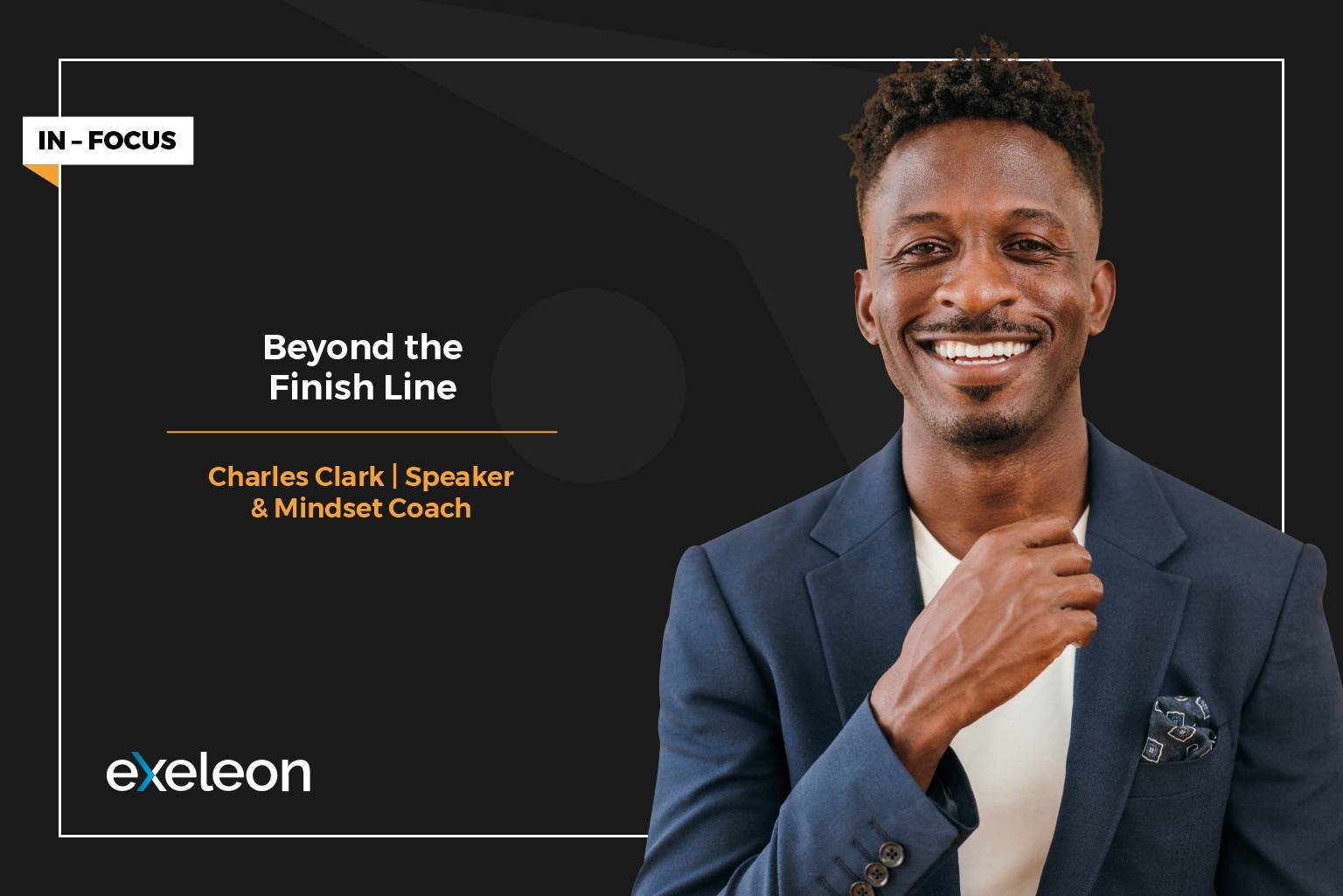
This interview with Charles Clark is part of Exeleon Magazine’s Influential Business Leaders to Follow issue, featuring Kevin MacRitchie on the Cover. Check out the digital version of this issue by clicking here.
Charles Clark, formerly ranked as the sixth fastest man globally at the IAAF World Championships in Berlin, experienced a life-altering injury that shifted his trajectory. What appeared to be a devastating setback became the foundation for a remarkable transformation. Through this journey, Charles discovered the importance of mastering and sustaining optimal mental well-being. Today, he is dedicated to empowering others to cultivate mental strength, believing that challenges hold valuable lessons that guide us toward fulfillment.
Discover Charles Clark’s journey from being an elite athlete to mental well-being advocate, and how he’s helping others redefine resilience and thrive beyond their physical and mental challenges.
Your journey from being ranked the sixth fastest man in the world to focusing on mental well-being is inspiring. Can you share the story of how a devastating injury became a catalyst for this transformation?
My career as an athlete peaked in 2009 when I became an NCAA National Champion in the 200-meter dash and secured my place as the sixth fastest man in the world at the IAAF World Championships in Berlin.
Being at the top of my game wasn’t just my passion; it was my identity. However, that identity was shattered in an instant when I suffered a 99% tear in my right quad muscle. I was told I’d never run as fast again.
The following two years were a battle, not just with recovery but with finding my footing in a world where I could no longer do what I loved most. This time forced me to confront a stark reality: my entire identity was wrapped up in my athletic ability, and without it, I felt lost.
This journey wasn’t just about healing physically but also about rediscovering who I was beyond the track. It was during this time, at my rock bottom, I truly began to understand the depth of my mental resilience. This realization marked the beginning of my transformation. It was clear that no one else could navigate this path for me. I had to take responsibility for my situation and, more importantly, my future.
This process of self-discovery and the emphasis on mental and emotional well-being has become the foundation of my life today. It’s inspired me to focus on mental health, not just for myself but as a message to share with others as they navigate their own ups and downs.
You emphasize mastering and sustaining optimal mental well-being. What does optimal mental well-being mean to you, and how do you guide others in achieving and maintaining it?
Optimal mental well-being, to me, is so much more than unwavering positivity. It’s about cultivating the mental fortitude to navigate life’s inevitable challenges and the mindset to cherish even the smallest moments of joy.
It’s the belief that true resilience—the cornerstone of a life worth living—can only be fostered on a foundation of robust mental health. In my experience, the challenge that countless people face in achieving happiness today can be traced back to what I refer to as our ‘PC’—our programming and conditioning.
This is often what stops us from breaking free from toxic thought patterns that hinder our ability to seize opportunities for growth. One critical aspect of achieving optimal mental well-being is mastering the art of the reset. It’s a process of identifying and altering the ingrained habits and beliefs that sabotage our well-being. The goal isn’t to embark on an endless quest for happiness but to cultivate a mindset where happiness can flourish naturally.
I help others find this reset by sharing strategies on stages around the world, through my writing in my books ‘Become Your Ideal Self: How to Heal Through Self Therapy’ and ‘The I in Team: The Playbook To Create A Winning Culture & A Thriving Business,’ and by embodying these principles in my daily life as a testament to how transformative a conscious mental shift can be.
Are there specific mental strategies or mindset shifts from your athletic career that you find applicable to everyday life?
The mindset of a winner, which I honed during my years as an athlete, is a fundamental part of my daily life. This mindset isn’t about standing on the podium with a gold medal; it’s about the relentless pursuit of excellence and the resilience to keep pushing forward, even when the odds are against you.
It’s realizing that the biggest competition is against the limits we set for ourselves, not against others. The mind, I’ve learned, is our most powerful tool. Like any muscle, its strength lies in how well we train it. I’ve experienced firsthand how the mind influences our thoughts, those thoughts shape our habits, and those habits, in turn, dictate our lives.
By initiating change at the mental level, we can transform our lives in ways we might never have imagined.
What practical advice do you offer to individuals seeking to enhance their mental well-being on a daily basis?
One of the best things we can do for ourselves daily is work towards a growth mindset. Embracing the idea that our brain’s capacity for learning and adapting is virtually infinite can fundamentally change how we approach setbacks. Rather than being tethered to specific outcomes, adopting a growth mindset allows us to reframe situations, exercise cognitive flexibility, and turn potential failures into stepping-stones for success and fulfillment.
A key aspect of this is the practice of repurposing our experiences. Just as a fallen tree in the Redwood Forest doesn’t signify an end but the beginning of a new ecosystem, our missteps can be the fertile ground for new growth. It’s about seeing beyond the immediate loss to the potential gains that can come from it.
To apply this in your life, I recommend a five-step process to repurpose any situation:
- Identify the situation that has led to mental stagnation.
- Reflect on the purpose this situation once served in your life.
- Honestly assess your role in arriving at this point.
- Seek a more positive or constructive meaning you can attach to the experience.
- Determine what comes next, empowering yourself to find new reasons to experience joy, love, and happiness.
This practice is about recognizing that you have the power to dictate whether a moment in your life is an endpoint or a beginning. If something in your life no longer serves you, ask yourself: how can you repurpose this experience to align more closely with the life you desire?
What are your aspirations for the future in terms of your work in mental well-being, and how do you envision making a lasting impact in this field?
My goal is to help people redefine their setbacks and unleash their full potential. Imagine a world where everyone is living their optimum lives with a sense of serenity. For me, that means sharing my insights on bigger stages and the release of my next book, ‘Guide to Thrive,’ scheduled for April 4th
I want my story to serve as a testament to the transformative power of resilience and the possibility of rebirth through mental fortitude. Ultimately, I aim to be a catalyst for change, inspiring a cultural shift that redefines how we view mental health, moving away from stigma and towards acceptance and compassion.
My goal is to see a world where mental well-being is not an afterthought but a fundamental aspect of daily life, where people are equipped with the tools and support, they need to thrive physically, mentally, emotionally, and spiritually.
Finally, what does being dynamic mean to you? How do you integrate the same thought into your leadership?
To me, being dynamic is inherently tied to how we respond to adversity. For a leader within a business context, being dynamic translates to viewing challenges not as obstacles but as opportunities for innovation. It’s about instilling a sense of purpose and direction in a team while also being flexible in achieving these goals. This means being steadfast in vision but nimble in execution, allowing for course corrections that keep the team moving forward without losing sight of the ultimate objective.
In essence, dynamic leadership is demonstrated through leading by example—showing that adaptability and resilience are not just responses to adversity but are proactive stances in all business endeavors. In my own life, I apply this approach by tackling each obstacle with the question, “What can this teach me?”
Follow Charles Clark on Instagram.










